

5 Highly Effective Teaching Practices. I remember how, as a new teacher, I would attend a professional development and feel inundated with new strategies.
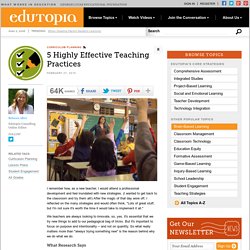
(I wanted to get back to the classroom and try them all!) After the magic of that day wore off, I reflected on the many strategies and would often think, "Lots of great stuff, but I'm not sure it's worth the time it would take to implement it all. " We teachers are always looking to innovate, so, yes, it's essential that we try new things to add to our pedagogical bag of tricks. But it's important to focus on purpose and intentionality -- and not on quantity. So what really matters more than "always trying something new" is the reason behind why we do what we do. What Research Says This leads me to educational researcher John Hattie, who wrote Visible Learning for Teachers: Maximizing Impact on Learning.
Hattie has spent more than 15 years researching the influences on achievement of K-12 children. How To Design A 21st Century Assessment - View Original Photo This is my 200th Blog Post on ASCD EDge.
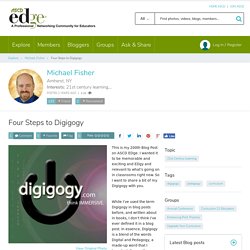
I wanted it to be memorable and exciting and EDgy and relevant to what’s going on in classrooms right now. So I want to share a bit of my Digigogy with you. While I’ve used the term Digigogy in blog posts before, and written about in books, I don’t think I’ve ever defined it in a blog post. In essence, Digigogy is a blend of the words Digital and Pedagogy, a made-up word that I loosely define as “how we teach with technology.” Now there are close to 10,000 results with entries from all over the world. Since its inception, the term has expanded in meaning to be more inclusive and enveloping of every effort made to bring the classroom into a contemporary zone.
I pay careful attention to the Blogosphere and the Twitterverse. I also still see some room for improvement. I’ve been seeing a lot of blog posts lately that advocate for technology events. Updated Comparison of Backchannel & Informal Assessment Tools. Last winter I published a series of charts in which I compared popular ed tech tools for things like blogging, informal assessment, and video production.

As is to be expected in the tech world, some of the tools in those charts have changed. Therefore, I'm now going through each chart and updating it. Yesterday, I published an update to my blogging platforms comparison chart. Today, I updated my chart comparing tools for backchannels and informal assessment. 3 Ways of Getting Student Feedback to Improve Your Teaching. During the summer, you'll want to improve your teaching and lessons, but how do you decide where to start?
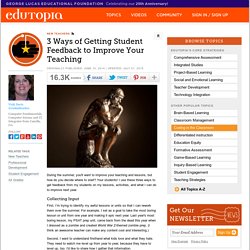
Your students! I use these three ways to get feedback from my students on my lessons, activities, and what I can do to improve next year. Collecting Input. Finley-53ways-check-for-understanding.pdf. Using Pre-Needs Assessment for Effective PD. I've had the pleasure to deliver and be part of countless sessions and workshops, and I can tell you from first-hand experience that there is nothing worse than a presenter who doesn't know his or her audience.
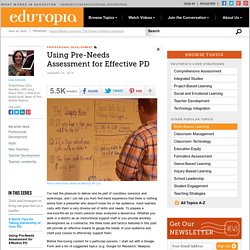
Adult learners carry with them a very diverse set of skills and needs. To prepare a one-size-fits-all (or most) session does everyone a disservice. Whether you work in a district as an instructional support staff or you provide ancillary development as a contractor, the three tools and tactics featured in this post will provide an effective means to gauge the needs of your audience and chart your course to effectively support them. Before fine-tuning content for a particular session, I start out with a Google Form and a list of suggested topics (e.g. 5 Fantastic, Fast, Formative Assessment Tools. I thought I could read my students' body language.
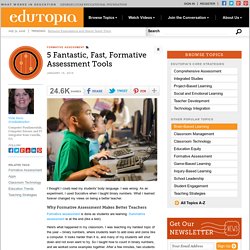
I was wrong. As an experiment, I used Socrative when I taught binary numbers. What I learned forever changed my views on being a better teacher. Why Formative Assessment Makes Better Teachers Formative assessment is done as students are learning. Here's what happened in my classroom. "We've got this, it's easy," they said. I looked at the other students and asked, "Do you have this? " They nodded their heads furiously up and down in a "yes. " SSAT workshop. Make It Count: Providing Feedback as Formative Assessment. Providing students with feedback on written work can, at times, feel like a burden.
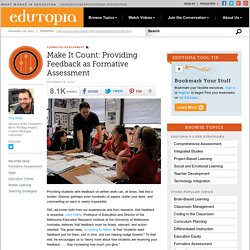
Dozens (perhaps even hundreds) of papers clutter your desk, and commenting on each is nearly impossible. Still, we know, both from our experiences and from research, that feedback is essential. John Hattie, Professor of Education and Director of the Melbourne Education Research Institute at the University of Melbourne, Australia, believes that feedback must be timely, relevant, and action-oriented. The good news, according to Hattie, is that "students want feedback just for them, just in time, and just helping nudge forward. " To that end, he encourages us to "worry more about how students are receiving your feedback . . . than increasing how much you give. " Stw-replicatingpbl-21stcacad-reflection-questions.pdf.
Dl-camarata-editable-rubric.docx. Feedback for Thinking: Working for the Answer. We run the risk of giving the wrong kind of feedback for students, and it's not because we are bad people.
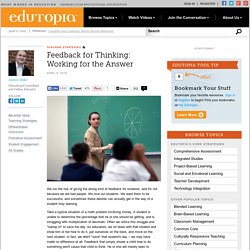
We love our students. We want them to be successful, and sometimes these desires can actually get in the way of a student truly learning. Take a typical situation of a math problem involving money. A student is unable to determine the percentage that he or she should be getting, and is struggling with multiplication of decimals. Often we notice this struggle and "swoop in" to save the day. 3 Strategies for Structured Teaching. 5 Highly Effective Teaching Practices. WiliamArticle.pdf. The 5 Keys to Successful Comprehensive Assessment in Action. Assessment is the key to good instruction.
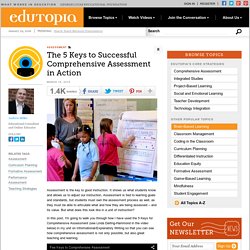
Developing Students’ Self-Assessment Skills. December 10, 2014 By: Maryellen Weimer, PhD in Teaching Professor Blog I’ve been rereading some of the research on student self-assessment and thinking about how students develop these skills.
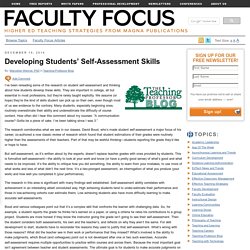
They are important in college, all but essential in most professions, but they’re rarely taught explicitly. We assume (or hope) they’re the kind of skills student can pick up on their own, even though most of us see evidence to the contrary. Many students, especially beginning ones, routinely overestimate their ability and underestimate the difficulty of course content. The research corroborates what we see in our classes. But self-assessment, as it’s written about by the experts, doesn’t replace teacher grades with ones provided by students. The research in this area is significant with many findings well established. Boud and various colleagues point out that it’s a complex skill that confronts the learner with challenging data. The Qualitative Formative Assessment Toolkit: Document Learning with Mobile Technology. What is qualitative formative assessment? Some call it anecdotal or informal assessment. However, such designations imply passivity -- as if certain things were captured accidentally.
I believe the word "formative" should always be included with the word assessment because all feedback mechanisms should help shape and improve the person (or situation) being assessed. Wedging the word "qualitative" into my terminology differentiates it from the analytic or survey-based measures that some associate with the term formative assessment. 5 Fantastic, Fast, Formative Assessment Tools.
Why I’m abandoning Socrative for Kahoot…at least some of the time. It is true that when I learn about a new tool, I tend to jump very quickly on board. But hear me out. Kahoot is a free, Web-based tool that allows you to survey students, ask formative assessment questions, or facilitate an online discussion on computers or mobile devices. So far, that is very similar to Socrative, which I have successfully used numerous times. For this post, I will be disucssing only Kahoot’s “quiz” features. Their discussion platform is content for another post. Kahoot! Create Surveys and Graded Quizzes with Google Drive » Teach Amazing!
Written by Teach Amazing! Using Google apps such as Google Forms and Google Sheets (spreadsheet similar to Microsoft Excel) is free and easy. These tools combine to provide and excellent way to receive feedback and even distribute self-graded quizzes. As of the date of this post, Google has updated the look of Google Drive and moved things around. So, even if you have done this before make sure you read this post to find out where everything is.
Step 1: Access Google Drive In your browser, navigate to drive.google.com/ and sign in to your Google account. Step 2: Create a Google Form To create a new form, which can be used as a survey or a quiz, click New > More > Google Forms. Step 3: Add Title, Description, and First Question Type a Title and Description for the Quiz.For the rest of this post we will use the word “quiz.” Step 4: Additional Questions. 5 Fantastic, Fast, Formative Assessment Tools. Top Tech Tools for Formative Assessment. Top Tech Tools for Formative Assessment.